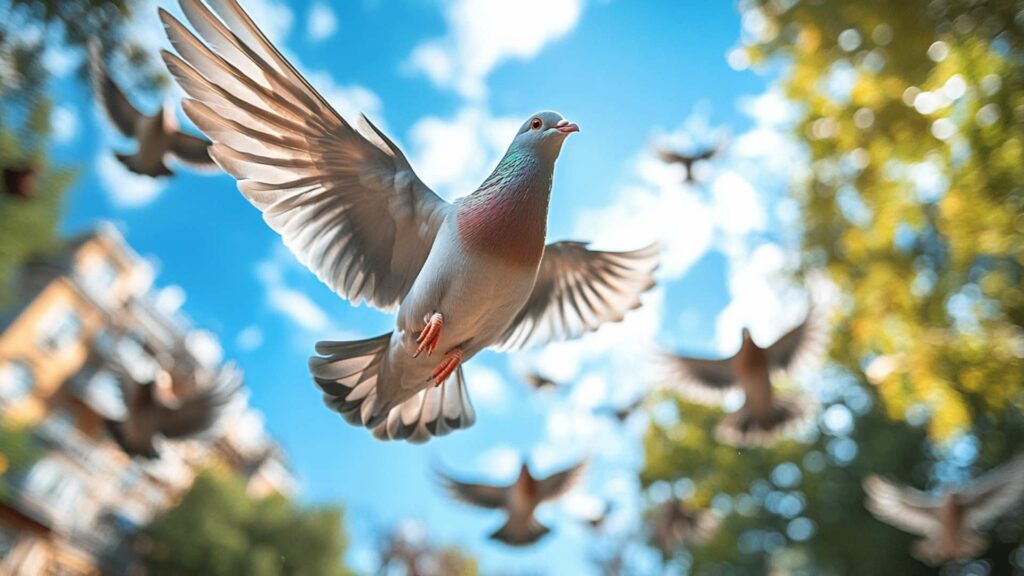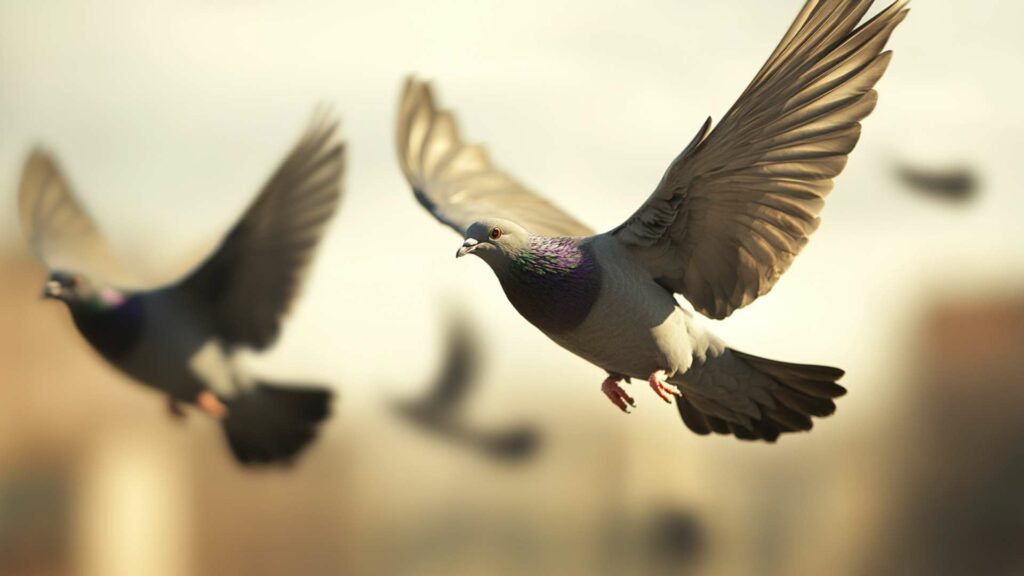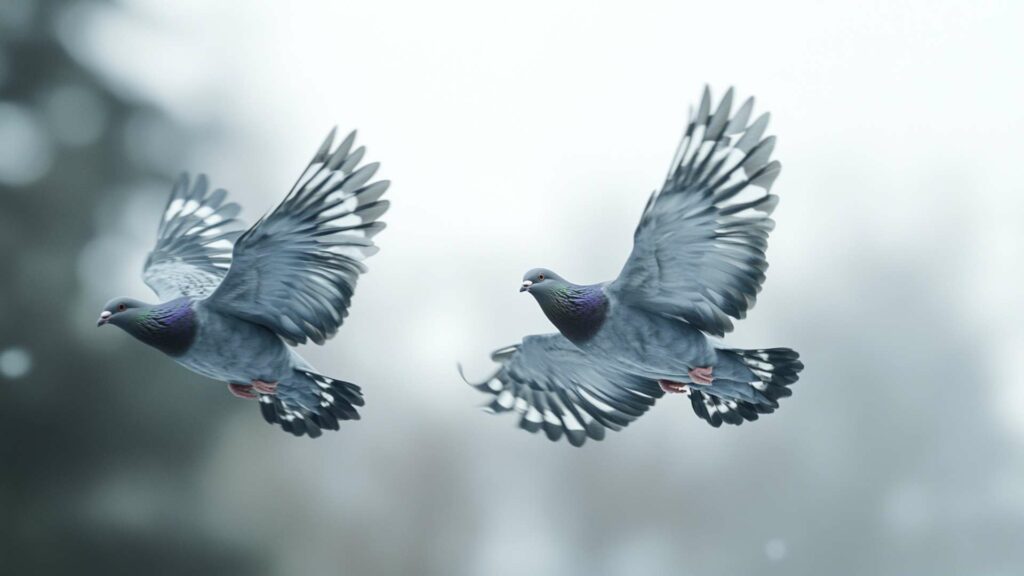Pigeons have always managed to captivate our attention with their intriguing behaviors. Whether it’s their graceful flight, distinctive cooing sounds, or the way they navigate cities with effortless ease, these birds have a certain charm that sets them apart. They are a common sight in urban areas and yet continue to maintain an air of mystery.
However, one behavior in particular stands out among the rest – their ability to puff up. This fascinating display never fails to catch our eye and leaves us questioning the reasons behind this peculiar behavior.
Puffing up as one of the intriguing behaviors
Among pigeons’ repertoire of distinct behaviors, puffing up is undoubtedly one that captures our attention and ignites curiosity. It is a sight that we often encounter while observing these avian creatures; they seem to inflate themselves like tiny feathery balloons.
The act of puffing up involves fluffing out their feathers and expanding their bodies considerably. This phenomenon is not exclusive to pigeons but can also be observed in other bird species such as peacocks during courtship displays, mating or when trying to appear larger for intimidation purposes.
Pigeon puffing up can serve several purposes depending on the specific circumstances and environment in which they find themselves. It’s truly mesmerizing how these birds fluff themselves up before our eyes, transforming from seemingly ordinary creatures into magnificent beings with voluminous plumage.
Understanding the Anatomy of Pigeons
Feathers and their importance
Feathers are the defining feature of birds, and pigeons are no exception. These animals’ remarkable plumages serve multiple purposes, making them essential for the survival and well-being of these beautiful creatures. Pigeons possess three main types of feathers: contour, down, and filoplume.
Contour feathers account for the majority of a pigeon’s plumage. These feathers have a strong central shaft with interlocking barbs that provide structure and shape to the bird’s body.
They also play a crucial role in enabling flight by providing lift and stability. Down feathers, on the other hand, are fluffy and soft, acting as excellent insulation to keep pigeons warm in colder temperatures.
Filoplume feathers are thin and hair-like, often found near contour feathers. They lack barbs but possess sensory receptors that help pigeons navigate their surroundings.
Pigeon’s respiratory system
Pigeons’ respiratory systems are marvels of efficiency that facilitate their ability to fly long distances while maintaining high oxygen levels in their bodies. One key component is their unique arrangement of air sacs alongside lungs.
Air sacs act as reservoirs that store air during both inhalation and exhalation phases. This allows for continuous airflow through the lungs, promoting efficient gas exchange.
The lungs themselves consist of millions of tiny air sacs called alveoli where oxygen is absorbed into the bloodstream while carbon dioxide is released. The role played by the respiratory system extends beyond respiration alone – it also directly influences how pigeons puff up their feathers.
By manipulating airflow within these intricate air sacs during puffing up behaviors, pigeons can create an impressive expansion effect that gives them an enlarged appearance to communicate dominance or attract mates. By understanding these intricate details about pigeon anatomy—specifically their feathers and respiratory system—we gain a deeper appreciation for the mechanisms that allow them to express their behaviors, such as puffing up.
The Purpose Behind Puffing Up

Thermoregulation to Maintain Body Temperature – Nature’s Fluffy Jacket
When pigeons puff up their chest and fluff out their feathers during sleep, it serves a vital purpose in maintaining their body temperature. Just like humans bundle up in winter coats to stay warm, pigeons create an insulating air layer by fluffing up their feathers. This allows them to trap a layer of air close to their bodies, effectively acting as a natural heating pad set on low.
When the weather turns chilly or during cold nights, these fluffy layers help the pigeon retain heat and prevent excessive loss through the surface area of their feathers. Furthermore, pigeons have a remarkable ability to adjust the position of their feathers to either trap or release heat, much like an adjustable thermostat.
By slightly altering the angle and spacing between the feathers on their chest and other body parts, they can regulate how much heat is trapped within those layers. This mechanism helps them maintain a comfortable body temperature even when faced with fluctuating environmental conditions.
Displaying Dominance or Attracting Mates – Puffed Feathers Speak Louder Than Words
Not only do pigeons puff up for practical reasons like thermoregulation, but they also employ this behavior as a means of communication within their social hierarchy and during courtship rituals. When male pigeons want to assert dominance over rivals or attract potential mates, they instinctively puff up their chest and display an enlarged appearance. By inflating themselves with air pockets strategically placed beneath specific feather groups, male pigeons create an imposing silhouette that intimidates rivals during territorial disputes.
The puffed-up chest of female pigeon signals strength and superiority in the avian realm. Additionally, when it comes to attracting mates, female pigeons are naturally drawn to males who can flaunt grandeur through puffed-up displays.
The puffed feathers enhance the visual appeal, demonstrating his suitability as a potential partner. It’s a captivating sight to witness these majestic creatures strutting their stuff with pride and confidence, using their puffed-up chests as a means of courtship expression.
Pigeons puff up for both practical and expressive reasons. Their ability to thermoregulate by creating an insulating layer of air with fluffed feathers showcases the remarkable adaptations nature has bestowed upon them.
Simultaneously, their puffed-up displays convey dominance and attract mates by visually emphasizing their strength and allure. So, the next time you spot a pigeon puff up its chest while perched on a ledge or parading in a park, take a moment to appreciate the intricate purpose behind this avian artistry.
Mechanism of Puffing Up

Muscle control over feather positioning
When it comes to puffing up, pigeons have an incredible ability to manipulate their feathers with precise muscle control. It all begins with the controlling muscles that are attached to the feather follicles.
These muscles, also known as piloerector muscles, allow pigeons to adjust the position of their feathers effortlessly. By flexing and relaxing these muscles, pigeons can raise or lower their feathers, resulting in a puffed-up appearance.
To achieve the desired effect of puffing up, pigeons engage in coordinated movements involving multiple muscle groups. They have specialized muscles located near their neck feathers that play a crucial role in creating the distinctive puffed-up look.
When these muscles contract and relax rhythmically, they cause the surrounding feathers to stand on end and create an illusion of increased body size. This coordinated effort gives pigeons the impressive ability to transform from a sleek-looking bird into a magnificent fluffed-up spectacle.
Manipulating air sacs for volume expansion
In addition to manipulating their feathers, pigeons also rely on another unique mechanism for achieving puffiness: manipulating their air sacs. Pigeons possess several air sacs within their bodies that are interconnected with their respiratory system. These sacs act like flexible containers capable of inflating and deflating.
To achieve volume expansion during puffing up, pigeons increase airflow into these air sacs by taking deep breaths through their nostrils. As they inhale deeply, more air fills these specialized sacs throughout various regions of their bodies.
This influx of air expands not only the lungs but also creates pockets of trapped air within certain cavities, such as around the chest area or beneath specific layers of feathers. The presence of these additional air pockets causes an overall increase in body size as more space is taken up by air.
This inflationary effect, combined with the manipulation of feathers, results in the unmistakable puffiness that makes pigeons truly stand out. It’s an incredible adaptation that allows pigeons to impress their peers, attract mates, or simply regulate their body temperature.
Factors Influencing Puffing Up Behavior
Environmental Conditions
Pigeons possess an exquisite ability to adapt to their surroundings, and the environmental conditions play a significant role in their puffing up behavior. One crucial factor is cold weather, which triggers a thermoregulation response in pigeons.
When the temperature drops, these intelligent birds fluff up their feathers to create a layer of insulating air, providing them with warmth and protecting other birds around them from the chilly air. It’s fascinating how they inflate their feathers like a heating pad set on high.
This behavior helps them maintain an optimal body temperature even when faced with frosty weather. Another noteworthy influence on the puffing up behavior of wings of pigeons is windy conditions.
When the wind blows fiercely, it not only affects a pigeon’s flight but also impacts its stability during display. Pigeons require steady balance and control over their movements when they puff up to attract mates or assert dominance.
In windy weather, this becomes more challenging as strong gusts of air can disrupt pigeons express their equilibrium, causing them to struggle while maintaining an inflated posture. Despite these difficulties, male pigeons will go through great efforts to impress female partners or establish their social standing within the flock by puffing up bravely in adverse wind conditions.
Social Context and Emotional State

In addition to external factors like environmental conditions, social context, and emotional state can significantly influence a pigeon’s tendency to puff up. Pigeon flocks have complex social structures with established dominance hierarchies. The pecking order determines which pigeons get preferential access to resources such as food or shelter and influences how they interact with one another.
When lower-ranking pigeons encounter dominant individuals within the flock, they are more likely to puff up as a submissive display rather than potential sign of aggression. Furthermore, emotional state plays a vital role in pigeon behavior; it affects how they interact with their surroundings and each other.
Pigeons, like humans, experience a range of emotions such as happiness, fear, and anger. When pigeons feel threatened or stressed, they might puff up their chest and neck feathers to appear larger and more intimidating to potential threats.
On the other hand, when pigeons are feeling content or attempting to attract a mate during breeding season, mating call, puffing up can be an expression of confidence and allure. It’s fascinating how these birds express themselves in such unique ways.
Conclusion
Understanding the factors that influence pigeons’ puffing up behavior allows us to appreciate their exceptional adaptability and intelligence. From braving cold weather to maintaining stability in strong winds, pigeons demonstrate remarkable skills in adjustability.
Moreover, the social context and emotional state of these birds play a crucial role in determining when and why they choose to puff up. Next time you notice a pigeon fluffing or puffing up its chest nearby, take a moment to consider the various reasons behind this behavior.
These feathered creatures are not only capable of protecting themselves from the elements but also adept at communicating their social status within the flock or expressing their emotions through body language. By observing pigeons’ intricate behaviors like puffing their tails up with curiosity and appreciation, we can gain deeper insights into the fascinating world of these avian marvels while recognizing their resilience and adaptability as fellow inhabitants of our shared natural environment.
Keep Pigeons Away with D-Termination: Leading Pest Control in Las Vegas!

Are pigeon problems bothering you? D-Termination is your solution. Our skilled team specializes in pigeon deterrence, reviving the cleanliness and integrity of your surroundings. Bid farewell to pigeons – opt for D-Termination for highly efficient pest control today!
You can reach us at 702-919-6310 or visit dtermination.com to schedule your pigeon control service and regain your space from these unwanted pests.
Frequently Asked Questions:
When a pigeon is fluffed up, it often means they’re trying to stay warm, comfortable, or relaxed.
Yes, pigeons puff up their feathers when they’re cold to trap warm air and maintain body heat.
Pigeons may puff up while sleeping to conserve warmth and feel secure.
Birds puff up their chest feathers primarily to regulate their body temperature and exhibit relaxation or comfort.







